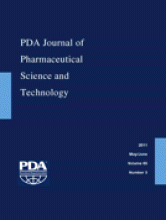Abstract
Isolators provide a high degree of protection for the product and/or the environment and operators in pharmaceutical production, as well as for analytical and sterility testing. Gloves allow for performing testing and for easy access to the process. Due to their nature—thin plastic, highly flexible—and their risk of puncture or rupture, they are regarded as one of the main potential sources of contamination. Glove integrity testing is therefore a main issue and has been addressed by many regulations such as those imposed by the USP, U.S. Food and Drug Administration, and Pharmaceutical Inspection Convention.
This paper presents a short overview of different glove integrity test procedures and their ability to detect leaking gloves. Additionally, extensive microbiological tests have been performed to give more evidence and cross-correlation to physical testing. Most of the physical tests have limitations either in detecting pinholes and/or they are difficult to implement for routine testing. Microbiological tests are only applicable for evaluation and validation purposes, but not for routine testing, because they are time-consuming and do not allow immediate action. Routine visual verification of gloves by trained personnel turns out to be a very reliable technique.
Additional microbiological tests supported by microbiological environmental monitoring helped to develop a new concept presented here on how to handle gloves with pinholes. It is proposed not to automatically consider a pinhole in a glove as a breach in isolator integrity, but to consider any action in view of controlling and monitoring the effective bioload on the outside of the gloves. With the combination of semi-automatic physical testing with independent protocol, visual inspection, and control of bioload through microbiological environmental monitoring potential contamination, risks can be minimized and maximum safety maintained.
LAY ABSTRACT: Isolators are enclosure designs to protect critical handling and process steps in pharmaceutical environments. They provide a high degree of protection for product and/or environment and operators against particles, potentially hazardous active principles, and microbial load.
Gloves mounted on windows and doors of the isolator allow for manipulation, performing testing, and access to the process. Due to their nature and their use with risk of puncture or rupture, they are regarded as a potential source for contamination. Glove integrity testing has therefor been addressed by regulations such as those imposed by the USP and the Food and Drug Administration.
This paper presents a short overview of various glove integrity test procedures and their ability to detect leaking gloves. Most of the tests have limitations either in detecting pinholes and/or they are difficult to implement for routine testing. Routine visual verification of gloves by trained personnel turns out to be a very reliable technique.
Additional microbiological tests led to a new concept presented here on how to handle gloves with pinholes and how to take action. With this approach, risks can be minimized and maximum safety maintained by controlling and monitoring the effective bioload on the outside of the gloves.
- © PDA, Inc. 2011
PDA members receive access to all articles published in the current year and previous volume year. Institutional subscribers received access to all content. Log in below to receive access to this article if you are either of these.
If you are neither or you are a PDA member trying to access an article outside of your membership license, then you must purchase access to this article (below). If you do not have a username or password for JPST, you will be required to create an account prior to purchasing.
Full issue PDFs are for PDA members only.
Note to pda.org users
The PDA and PDA bookstore websites (www.pda.org and www.pda.org/bookstore) are separate websites from the PDA JPST website. When you first join PDA, your initial UserID and Password are sent to HighWirePress to create your PDA JPST account. Subsequent UserrID and Password changes required at the PDA websites will not pass on to PDA JPST and vice versa. If you forget your PDA JPST UserID and/or Password, you can request help to retrieve UserID and reset Password below.






